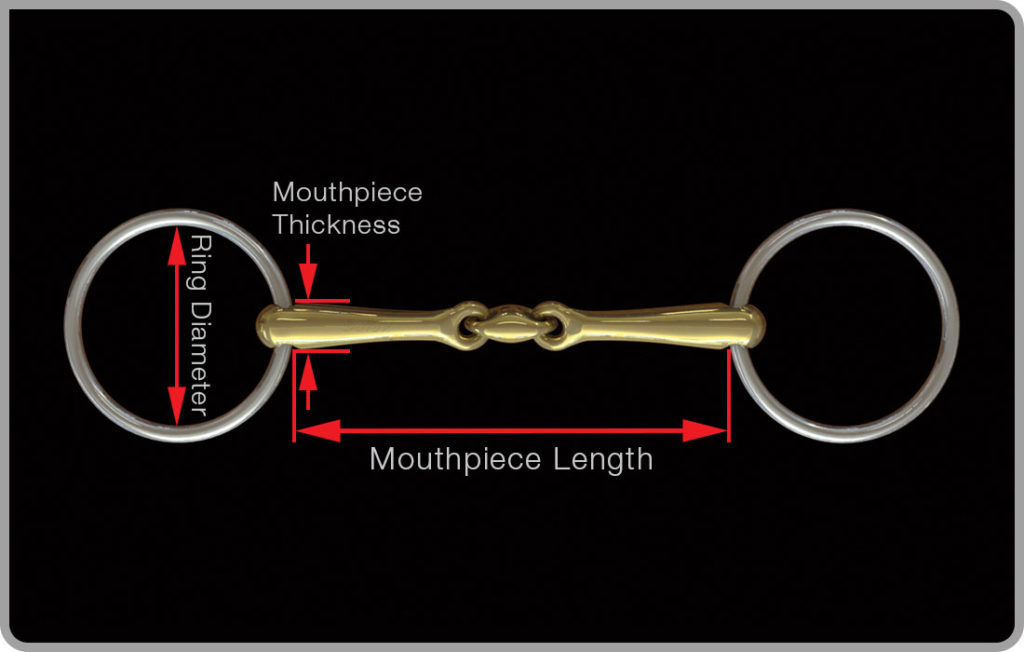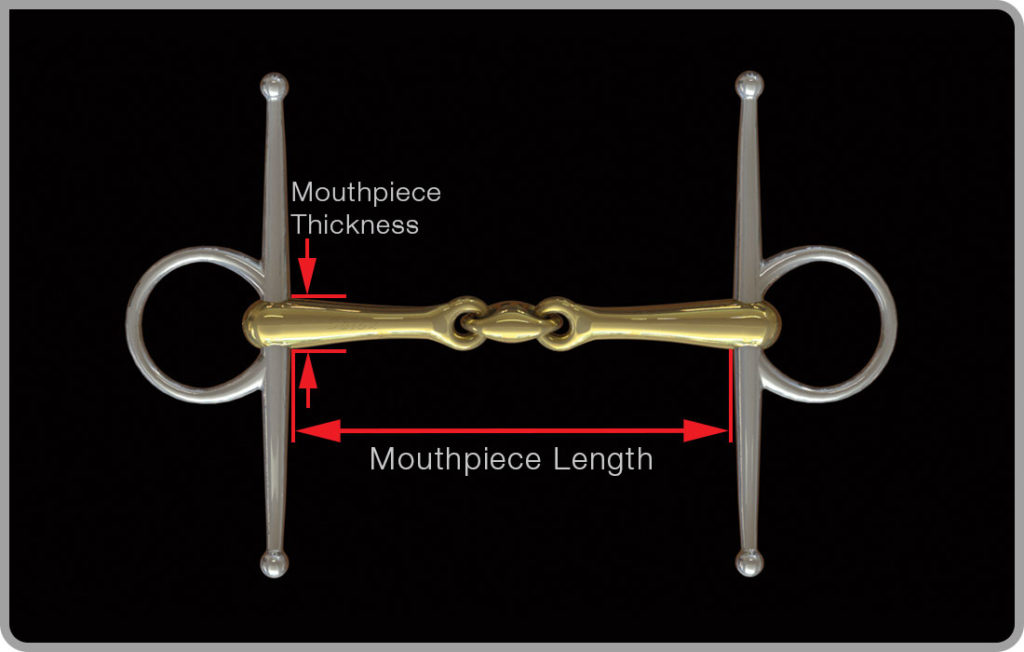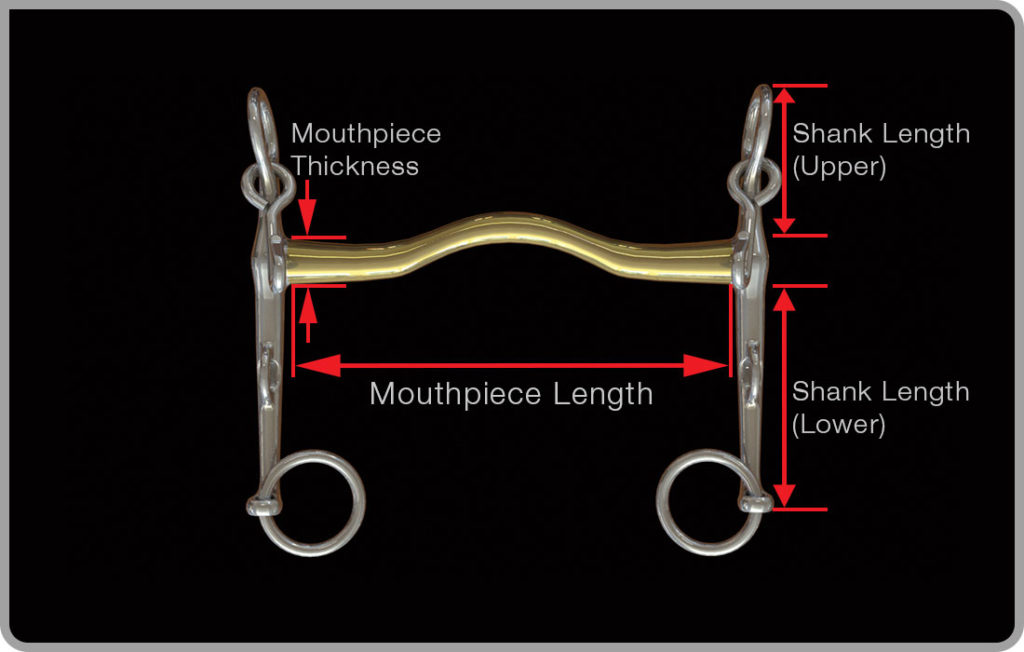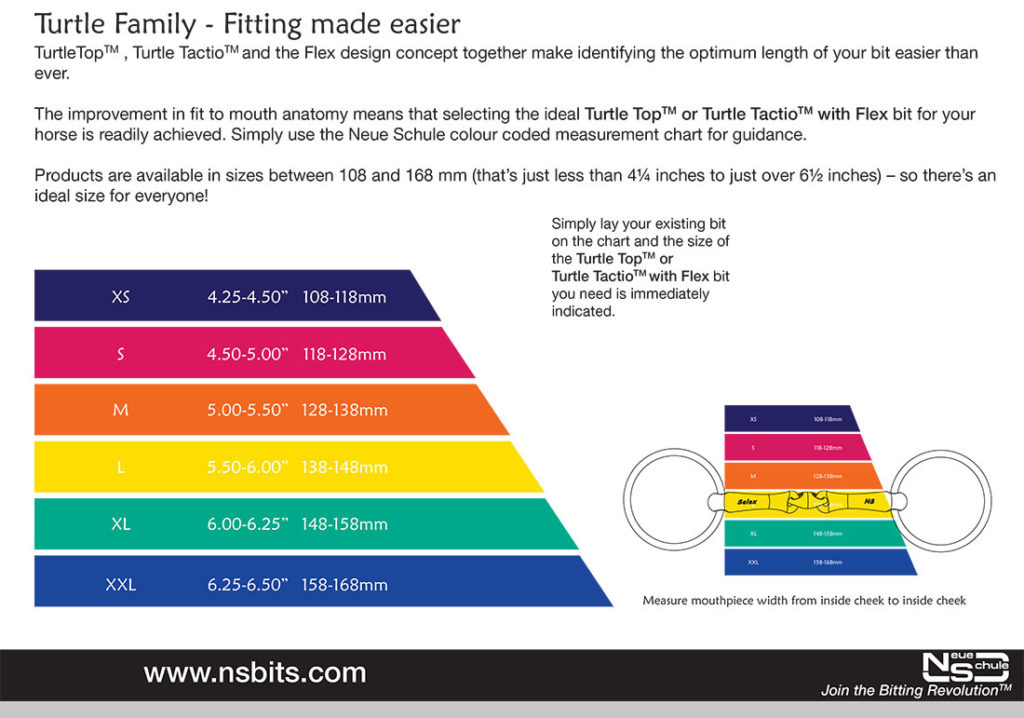There are various measurements to consider when sourcing and assessing the correct size of bit including length, thickness, ring size and design.
Loose Ring Bits
The picture below demonstrates a loose ring snaffle. Other cheeks that are measured this way include the Universal, Beval and Balding Gag and the measurements to consider here are:
- Mouthpiece Length: The measurement is taken by placing the bit on a flat surface and pulling the rings apart, so the bit is at its maximum length. The measurement is taken along the full length of the mouthpiece from the inside edge of the loose ring to the inside edge of the opposite loose ring and can be measured in inches or centimetres.
- Mouthpiece Thickness: This measurement is taken adjacent to (next to) the cheek just before the hole that the ring slides through. Again, if you put the bit on a flat surface, you can slide a tape measure at right angles below this point and, if you look from above, you can see the measurement of the diameter. The most accurate way to measure the diameter is using a set of callipers, which are widely available.
- Loose Ring Diameter: This measurement is taken from the inner edge of the loose ring and is generally measured in millimetres; 70 mm being the average for a standard loose ring; and 55 mm the typical bridoon size.

Fixed Cheeks
Fixed cheeks include the Baucher, D-Ring Full Cheek, Eggbutt, Pelham, NS Jumper, Cheltenham, Nelsonand our Weymouth range. The picture below, showing the NS Tranz Full Cheek is a good example of the points to measure at for this type of bit.
The mouthpiece thickness is measured directly adjacent to the cheek.

Weymouth
When sourcing a weymouth, there are a couple of additional measurements to consider as demonstrated in the picture below.
- Shank Length (lower): This measurement is taken from below the mouthpiece to the bottom of the shank (not to the bottom of the loose ring) and is generally done in centimetres; 5cm, 7cm and 9cm are the options that are available within the Neue Schule Collection. The legal length for FEI Dressage is 10cm.
- Shank Length (upper): In FEI Dressage the ruling states that the length of the upper shank must not exceed the length of the shank below. The Neue Schule range has been developed to fall within this ruling.

Our Waterford Mouthpiece Range
Owing to the unique LipSMART™ design of the Neue Schule Waterford mouthpiece we would generally suggest that you use the same sizing as your current bit in relation to the cheekpiece design that you use. For example, if you currently use a fixed cheek and want to progress onto a Waterford fixed cheek we advise staying in the same size as your current bit. The same goes if you are moving from a loose ring into another loose ring. A change in mouthpiece size is generally advised when moving from a loose ring to a fixed cheek or vice versa. We suggest that when moving from a loose ring to a fixed cheek that you down size by ¼ of an inch. By this logic, when moving from a fixed cheek to a loose ring we generally recommend sizing up by ¼ of an inch.
Our Verbindend Mouthpiece Range
Owing to the uniquely shaped cannons of the Verbindend it does shorten up slightly more than other double-jointed designs that have a straighter and more traditional mouthpiece arm. So, occasionally we do find that in order to obtain a correct fit we do need to increase the size by a ¼ of an inch.
Our Turtle Top and Turtle Tactio Range
Our Turtle Top and Tactio range are measured differently to how traditional snaffles are measured. This is because they have shaped cannons that conform to the horse’s mouth, and therefore don’t lie flat when placed on a table. However, we have made a fantastic sizing guide that will help you to measure your Turtle Top and Turtle Tactio bits:

This fantastic sizing guide is included in all our Product Guides to make sizing the Turtle range easy!
Mouthpiece Sizes
Neue Schule traditional mouthpieces are available in a range of sizes between 4″ (101 mm) and 6.5″ (165 mm). The table below shows the imperial/metric conversions.
| Imperial (inches) | 4.00 | 4.25 | 4.50 | 4.75 | 5.00 | 5.25 | 5.50 | 5.75 | 6.00 | 6.25 | 6.50 |
| Metric (mm) | 101 | 107 | 114 | 120 | 127 | 133 | 140 | 146 | 152 | 159 | 165 |
Size guides
Cheek Sizes
Cheek measurements vary dependant on cheek style and requirement, the table below shows the various options.
| Cheek Type | Variations |
| Loose Ring | 45mm, 55mm, 65mm, 70mm |
| Weymouth | 5cm, 7cm |
| Pelham | 5cm, 7cm |
Size guides
Question
How do I go about measuring my loose ring mouthpiece thickness, length and ring size?
Information
There are various measurements to consider when sourcing and assessing the correct size of bit including length, thickness, ring size and design.
We Say
The picture below demonstrates a popular loose ring snaffle, the NS Team Up (9012). Other cheeks that are measured this way include the Universal, Beval and Balding Gag and the measurements to consider here are:
- Mouthpiece Length: The measurement is taken by placing the bit on a flat surface and pulling the rings apart so the bit is at its maximum length. The measurement is taken along the full length of the mouthpiece from the inside edge of the loose ring to the inside edge of the opposite loose ring and can be measured in inches or centimetres.
- Mouthpiece Thickness: This measurement is taken at the widest part near to the cheek just before the hole that the ring slides through. Again, if you put the bit on a flat surface, you can slide a tape measure below this point and, if you look from above, you can see the thickness. The most accurate way to measure the thickness is using a set of calipers, which are widely available.
- Loose Ring Diameter: This measurement is taken from the inner edge of the loose ring and is generally measured in millimeters; 70mm being the average for a standard loose ring; and 55mm the typical bridoon size.
